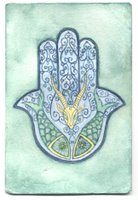The website that hosts the video calls him a "chimp" which for those who don't know, is partly true and partly wrong. He is a bonobo. They are also called pygmy chimps.
 Kanzi and his extended bonobo family formerly lived at the Language Research Center at Georgia State University where they learned to use lexigrams, symbolic language equivalents of Japanese kanji (the similar words being coincidental, Kanzi means treasure in Swahili). NPR carries a nice summary of how Kanzi learned to use language. This is significant because Kanzi did not learn using the Skinnerian conditioning methods that other ape language projects had relied on. Perhaps this is the reason for his success, but it could very well be that Kanzi, and bonobos in general, are primed for language acquisition like humans are.
Kanzi and his extended bonobo family formerly lived at the Language Research Center at Georgia State University where they learned to use lexigrams, symbolic language equivalents of Japanese kanji (the similar words being coincidental, Kanzi means treasure in Swahili). NPR carries a nice summary of how Kanzi learned to use language. This is significant because Kanzi did not learn using the Skinnerian conditioning methods that other ape language projects had relied on. Perhaps this is the reason for his success, but it could very well be that Kanzi, and bonobos in general, are primed for language acquisition like humans are.Kanzi and his teacher's achievements are remarkable, but so is the limit of his language abilities. He does understand syntax (which is a HUGE accomplishment & discovery for science), but he still doesn't have the ability to carry on complex conversations, tell stories, use past tense and other tenses (though there is a way he can talk about the future, usually his desires for the immediate future), and his vocabulary is nowhere near the hundreds of thousands of words that adult humans have in their repertoire. To be fair, this may be dependent on the time and creativity of his teachers who must design new lexigrams.
 Now that Kanzi and Co. have reached retirement age (there should be a primate AARP, All Ape Retirement Program... definitely not American Association of Retired Primates, why be exclusive to only 'american' primates? After all, there are aging research apes in Japan, too [who are also involved in language and cognition studies]... of course my suggested way is hardly inclusive as it leaves out all non-apes... but anyway, I digress), they live at the Great Ape Trust in Des Moines, Iowa. The bonobos pictured snoozing in my photo above live at the San Diego Zoo. They look retired to me.
Now that Kanzi and Co. have reached retirement age (there should be a primate AARP, All Ape Retirement Program... definitely not American Association of Retired Primates, why be exclusive to only 'american' primates? After all, there are aging research apes in Japan, too [who are also involved in language and cognition studies]... of course my suggested way is hardly inclusive as it leaves out all non-apes... but anyway, I digress), they live at the Great Ape Trust in Des Moines, Iowa. The bonobos pictured snoozing in my photo above live at the San Diego Zoo. They look retired to me.From their website:
"Great Ape Trust is dedicated to providing sanctuary and an honorable life for great apes, studying the intelligence of great apes, advancing conservation of great apes and providing unique educational experiences about great apes. Great Ape Trust of Iowa is a 501(c) 3 not-for-profit organization and is certified by the American Zoo and Aquarium Association (AZA)."
It looks like Sue Savage-Rumbaugh finally realized her dream of giving Kanzi & Co. a better life than a laboratory could provide. Maybe she just got tired of living in Georgia. Or maybe her funding ran out. Or maybe Kanzi told her he was ready to live somewhere else.
In any case, the Great Ape Trust looks like a wonderful place and there is still plenty of quality research being conducted by more than a dozen LRC affiliated scientists, including Dorothy Fragaszy who along with Leighty published "Primates in cyberspace: Using interactive computer tasks to study perception and action in nonhuman animals. 2003. Anim. Cogn. 6: 137-139." as well as "Joystick acquisition in tufted capuchins (Cebus apella).2003. Anim. Cogn. 6:141-148." I bet these two experts could provide some very interesting commentary on Kanzi's Ms. Pac-Man skills.
 Rather than playing Ms. Pac-Mac, over the weekend I painted this, a post card sized watercolor of a Hand of Fatima inspired by tiles I saw on a beautiful house in El Jem, Tunisia.
Rather than playing Ms. Pac-Mac, over the weekend I painted this, a post card sized watercolor of a Hand of Fatima inspired by tiles I saw on a beautiful house in El Jem, Tunisia.


4 comments:
hi! i got sent here from a comment you sent to Heather. i know Kanzi! my teacher told me about this bonobo monkey. its very smart and its like a human, i heard.
please come to my blog, www.syfox133.com
cya,
syfox
Hi Slyfox133,
Thanks for your comment. Kanzi is indeed very bright. Apes generally are especially when they get to go to "school" like Kanzi did!
Remember bonobos are apes, not monkeys. Lots of people get the two confused but it;s easy to keep them straight: Monkeys have tails; apes don't.
Humans are apes. So are chimps, gorillas, and orangutans. Gibbons are called "lesser apes" only because they are a lot smaller than the "land apes" (gibbons are arboreal meaning they live high in the canopies of trees). Gibbons are also more like monkeys because they don't show the same cognitive skills that other apes do... i.e. they aren't as "smart."
I keep hearing that kanzi understands syntax but no one has said exactly what phrase was understood or put together by kanzi.
can someone answer this.
not4others,
It's not just one phrase that Kanji has demonstrated syntax for, but several different ones.
To demonstrate an understanding of syntax, he'd have to show he understands word order - for instance - the difference between pouring water into soda vs pouring soda into water.
I have seen Kanji correctly perform such actions when asked. If asked to water water into Coke, he does (rather than pouring Coke into water).
Another way he has demonstrated an understanding of syntax is to understand prepositional phrases: e.g. Take the pine needles in the refrigerator outdoors. Rather than taking the pine needles sitting in front of him outside, he goes to the fridge to take the ones inside it outdoors.
That demonstrates a remarkable understanding of language - one that is unsurpassed by any other non-human.
~ Thanks for you comment and question!
Post a Comment